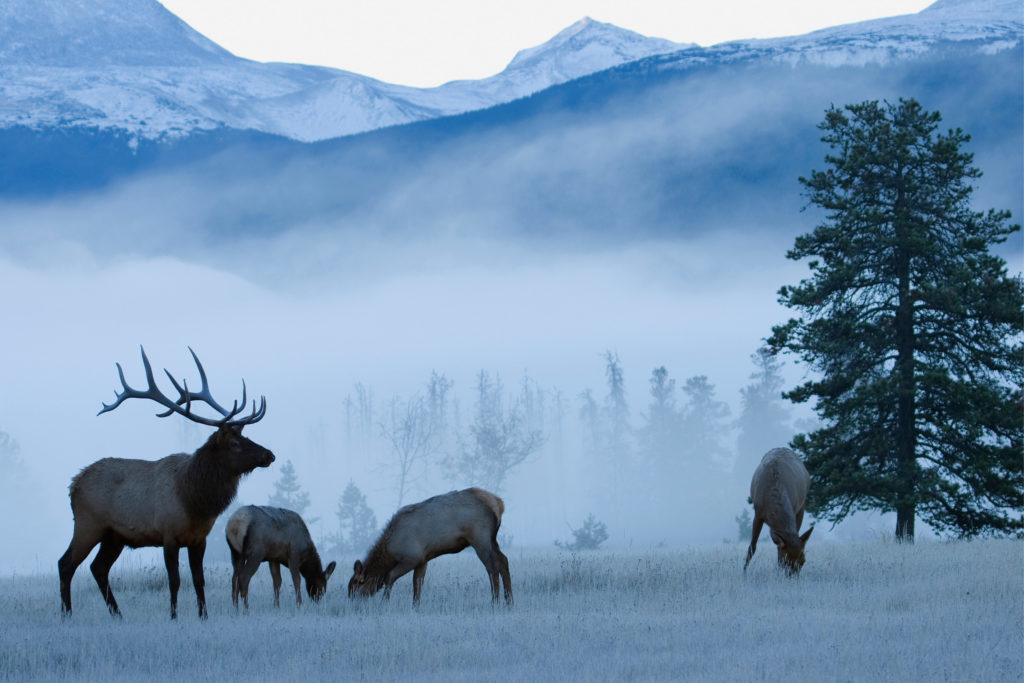It’s Bugle Season
Growls, barks, glunks, chuckles, and whistlesBLOG
Blog by Phoebe Coburn | Communications Specialist, Teton Conservation District
Growls, barks, glunks, chuckles, and whistles. Elk may be the most vocal big-game animal in North America. In the Rocky Mountains, there might be no sound that is quintessentially more ‘fall’ than the elk bugle. For me, the emotive sound evokes a unique feeling somewhere betwixt fear and awe, daze and wonder, and nostalgia and appreciation. Morgan Graham, Teton Conservation District’s GIS & Wildlife Specialist, says, “The sound of a bugle stirs up a feeling of being sent back to the age of the dinosaurs. Tingling in my ears and on the back of my neck. Ethereal. Primordial. Mystical beasts. It’s easy to see where inspiration for unicorns came from.” Such a feeling lends itself to questions.

WHY DO ELK BUGLE?
Male elk bugle during the ‘rut,’ the mating season running from September through October. During the rut, male elk have one (and only one) goal: mate. Bugling is a key part of this autumn ritual. But what precipitates this distinctive sound? I decided to explore this question because I have a childhood memory of someone telling me that the short days trigger bugling. Was that the elk-equivalent of an adult telling me that babies come from storks? So, I did some fact-checking and it turns out that yes, the short days do trigger bugling. But, whoever told me this interesting fact left out a few key details that kept me wondering all these years.
The rut is associated with the autumn equinox because the short days trigger hormone changes in elk, according to this interview with Colorado Parks and Wildlife’s big game manager, Andy Holland. “Right now the days are getting shorter, which affects melatonin levels. That triggers hormone changes in both bulls and cows. Bull testosterone levels can increase 1,000 times,” Andy said in the interview.
In female elk, the hormone changes cause them to go into estrus and release an alluring pheromone that makes the male elk go wild. While the females are wisely putting on pounds before the winter months, male elk are losing weight because they’re too busy showing off for the ladies to bother eating. Morgan says, “If you’ve ever had the pleasure of watching or listening to a bull elk defend or attract a harem during rut, you know first hand how personal preservation is the last thing on their mind. People shouldn’t be surprised if an incredible roadside photo opportunity quickly escalates into 800 lbs. of wapiti whoop-*** attempting to destroy you, your pet, or your car. These are wild animals at their wildest. For everyone’s sake, make sure to give them space. Spotting scopes, telephoto lenses, and binoculars are great investments.”
The rut happens at the same time every year for an important reason—all the babies need to be born at the exact right time in the late spring. Born too early, and the forage doesn’t provide enough nourishment for a nursing mother. Born too late, and the calves aren’t big enough to survive the next winter.

DO FEMALE ELK BUGLE?
Yes! They do! But rarely. Female elk will occasionally belt a bugle in the spring, most often in the late morning hours. (Interesting side note: the earliest description of female bugling I found online was Olaus Murie’s 1932 article “Elk Calls” in the Journal of Mammalogy. The article is still frequently cited today.) But why do they bugle in the spring? Biologists don’t know exactly, but this article (also in the Journal of Mammalogy) suggests that “Bugling by female elk may be associated with high-stress periods and hormonal changes accompanying gestation and lactation, as proposed by Espmark (1964) regarding behavioral changes in female reindeer.” A female elk’s bugle sounds similar to a male’s bugle, but generally a little shorter in duration.
WHAT ARE THEY SAYING?
The same article provides a picture of the functions of different bugle vocalizations in elk social behavior. Bugles sound different—some aggressive, some non-aggressive, some with lots of grunts, and some with a long reverberating whistle. The article describes most bugles as having three parts: an on-glide, whistle, and off-glide. Depending on the pattern of frequencies, it’s thought that the elk are conveying different messages. A male elk might be trying to attract a mate with his bugle, corral the females, assert his dominance over other males, assess the fighting ability of other males, or persuade a female avoiding his advances.
Fun fact: A lesser known bull elk vocalization known as the “glunk,” which sounds like a low-frequency drum or popping. It is heard when a bull is typically trailing a herd of cows. Some say it is an expression of dominance and personal identifier to the cows, while others assert it is the sound of the bull gulping the scent trail of the cows to determine whether they are in estrus.
WHERE CAN I HEAR ELK BUGLING?
Just about anywhere in Jackson at this time of year! I heard a few distant bugles in the wee hours this morning from my cabin in Wilson. Along the Moose-Wilson road at dawn or dusk is a good place to start, and then work your way north through the park. Some of the best bugles I’ve heard were on the shores of Shoshone Lake in Yellowstone. If you haven’t heard an elk bugle before, the video below just doesn’t do the mystical sound justice.
Send us a message at info@tetonconservation.org if you have any great bugle stories or know of any interesting information we left out. Thanks for reading!
Phoebe Coburn is a Communications Specialist for the Teton Conservation District
